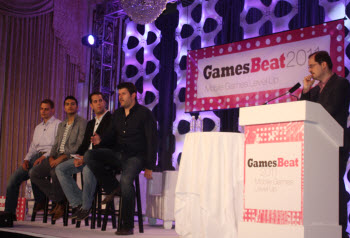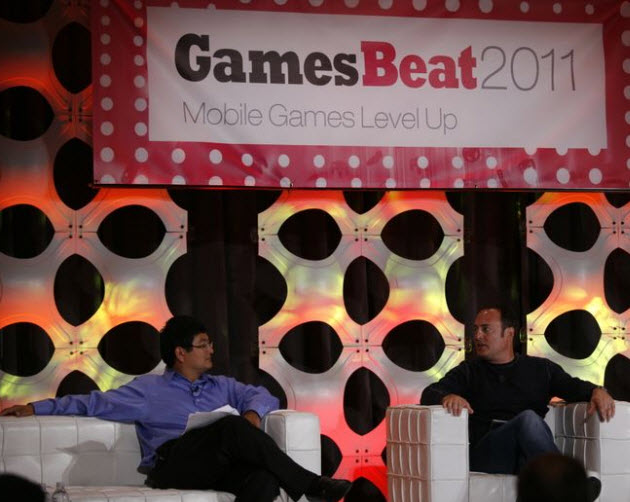 Our well-attended GamesBeat 2011 conference took place this week, and here’s what you missed.
Our well-attended GamesBeat 2011 conference took place this week, and here’s what you missed.
As I noted in a preview story on mobile games, the conference was all about the wide-open battle for control of the emerging mobile gaming market. The highlights below follow the chronological appearance of the speakers. It’s a long story, but it will tell you what the conference was like in case you missed it.
Fireside chat with Brian Farrell
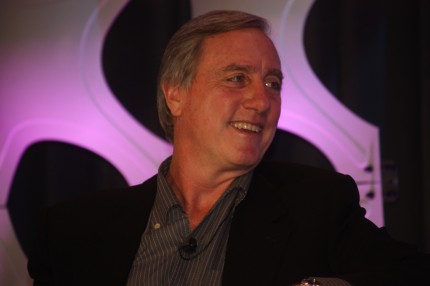 Brian Farrell (left), chief executive of THQ, opened the conference, replacing Bing Gordon, the partner at Kleiner Perkins who was muzzled because Zynga (where he is a board member) filed papers to go public. Farrell confessed to having “market valuation envy” (THQ’s stock price is lower than many game startups) but said that, once you go public, someone is going to put a price on your company every day whether you like it or not. He said that he was planning on coming to GamesBeat anyway (before we asked him to speak) because his company is making its moves into digital gaming and wants to be part of the conversation alongside gaming startups.
Brian Farrell (left), chief executive of THQ, opened the conference, replacing Bing Gordon, the partner at Kleiner Perkins who was muzzled because Zynga (where he is a board member) filed papers to go public. Farrell confessed to having “market valuation envy” (THQ’s stock price is lower than many game startups) but said that, once you go public, someone is going to put a price on your company every day whether you like it or not. He said that he was planning on coming to GamesBeat anyway (before we asked him to speak) because his company is making its moves into digital gaming and wants to be part of the conversation alongside gaming startups.
You really have to act like a startup, think like a startup within the company in order to survive,” he said.
THQ is focused on making fewer games with better quality. But it is also paying attention to digital gaming where it can partner with other companies with expertise in the area. Farrell said that the future of mobile games for THQ was much more likely to be in the new smartphone and tablet devices based on Apple’s iOS or Google’s Android, rather than the dedicated portable game systems from Nintendo and Sony. Farrell’s views showed me that traditional game publishers aren’t wed to their old ways; they’re going where the money is.
Fireside chat with Trip Hawkins
 Farrell said that game companies had to adapt or die. He was diplomatic when it came to platform owners. But Trip Hawkins (right), chief executive of Digital Chocolate, came on stage next and compared platform owners to “feudal landlords.”
Farrell said that game companies had to adapt or die. He was diplomatic when it came to platform owners. But Trip Hawkins (right), chief executive of Digital Chocolate, came on stage next and compared platform owners to “feudal landlords.”
“I think we actually had our golden age when game development was using floppy disks and it was an open, free platform when we could all make games that we wanted to make,” he said. “Nintendo came along and software licensing came in and we have been in a dark age since then.”
The developers are the serfs in this war among the feudal lords. He said that in the modern game industry, native apps on platforms such as Apple’s iOS keep developers shackled. Hawkins said that browser, supported by technologies such as HTML5, could set the serfs free. Content should be set free, he added. Developers who publish t the web will be able to move across platforms, update without the need for approval, and create what they want.
I asked him, “Will the browser bring us a republic of gaming?” He said, “We need to own our land.” He suggested that developers go cross-platform, lower the cost of acquiring customers, maximize their monetization, and cooperate.
“How many great companies have been built on the world wide web, which is an open platform?” he asked. “The list just goes on and on. And Nintendo’s been doing things this way for 25 years and there are no great companies that have been built on the back of Nintendo.”
I mentioned Zynga has built a big business on top of Facebook, but Hawkins noted that it was the exception. Zynga grew quickly to its No. 1 position because Facebook made the mistake of making its news feed too viral, polluting its stream with too many game promotions. Hawkins’ talk spurred a lot of discussion about how there are plenty of indie successes, such as Minecraft.
Just as our keynote speaker Nolan Bushnell was about to take the stage, Electronic Arts announced it was acquiring PopCap Games for at least $750 million. That explained why both EA and PopCap dropped out of speaking roles at the conference. EA’s move was a necessity to catch up to Zynga, which was also named as a bidder for PopCap, which I joked “pretended” to go public so that it could get acquired. EA’s stock price fell after the deal partly because of the high price. But EA said the deal would place it in an excellent position in the fast-growing social and mobile sectors.
 One reason we decided to focus on mobile games at GamesBeat 2011 was that Zynga had locked up the social game market on Facebook, since it has more users than the top 15 rivals combined on that platform. But mobile is wide-open territory, and EA’s move with PopCap is an attempt to grow bigger within that mobile category.
One reason we decided to focus on mobile games at GamesBeat 2011 was that Zynga had locked up the social game market on Facebook, since it has more users than the top 15 rivals combined on that platform. But mobile is wide-open territory, and EA’s move with PopCap is an attempt to grow bigger within that mobile category.
Keynote speech by Nolan Bushnell
Bushnell, the founder of Atari, talked about the game industry’s hilarious history and his own mistakes, like failing to invest in Apple when Steve Jobs and Steve Wozniak offered a third of the company to him for $50,000. Bushnell said he plans to disrupt early education through his new startup, Speed to Learn, which mixes lessons with game mechanics. His Wordplay.com site can teach Spanish five or six times faster than the leading language software, Rosetta Stone, Bushnell claimed. He foresaw a “golden age of creativity” coming with the falling costs of making games for mobile devices. But he urged entrepreneurs to “mistrust consensus.” Social networks are “overdone” now, he says.
“Does anybody want to plant more cabbages?” he joked, in reference to the repetitive nature of FarmVille.
Bushnell is just as much a huckster and showman as he was at Atari, always entertaining and also illuminating. He is still active in starting new companies and is an optimist about innovations such as cloud gaming, augmented reality, and tablet computers.
Raising a big pile of money
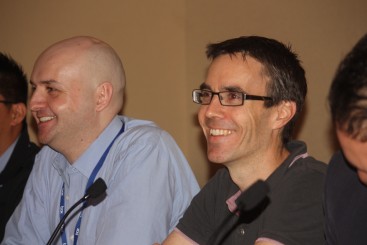 In a panel on raising money, Joe Kraus (pictured on right), a partner at Google Ventures, acknowledged that venture capitalists haven’t had a good track record investing in game companies. Only in the last few years have venture investments poured into games and relatively few investors — Kleiner Perkins, DCM, Norwest Venture Partners and Accel among them — have had decent successes. Just about everyone else missed the boat with social games and gaming, Kraus said, because there wasn’t any indication that the companies would be successful and they required a lot of capital. Those companies that have succeeded have done so in part because they have made their business more predictable and scientific through the use of analytics and rapid feedback cycles.
In a panel on raising money, Joe Kraus (pictured on right), a partner at Google Ventures, acknowledged that venture capitalists haven’t had a good track record investing in game companies. Only in the last few years have venture investments poured into games and relatively few investors — Kleiner Perkins, DCM, Norwest Venture Partners and Accel among them — have had decent successes. Just about everyone else missed the boat with social games and gaming, Kraus said, because there wasn’t any indication that the companies would be successful and they required a lot of capital. Those companies that have succeeded have done so in part because they have made their business more predictable and scientific through the use of analytics and rapid feedback cycles.
“We’ve moved from the gaming space from the age of artists to the age of mathematicians,” said Menlo Ventures managing director Shervin Pishevar. “I don’t think Zynga is a gaming company, it’s a business intelligence company.”
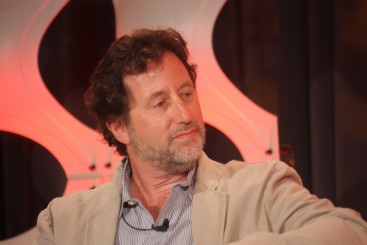 Longtime game and toy developer Jordan Weisman (left) said he was drawn to mobile gaming because of the quick turnaround times and lower costs compared to console games that often turn into five-year efforts. His last company, Smith & Tinker, foundered with its plan to create a toy-like device to go with its web game. That was due in part to the increasing popularity of kid-oriented devices like the iPod Touch, which offered many more game options. After that experience, Weisman decided to start a new mobile game company, Harebrained Schemes, which is making its first game, Crimson, for new mobile publisher Bungie Aerospace. You can bet that this talent migration from hardcore console games to social and mobile is going to continue.
Longtime game and toy developer Jordan Weisman (left) said he was drawn to mobile gaming because of the quick turnaround times and lower costs compared to console games that often turn into five-year efforts. His last company, Smith & Tinker, foundered with its plan to create a toy-like device to go with its web game. That was due in part to the increasing popularity of kid-oriented devices like the iPod Touch, which offered many more game options. After that experience, Weisman decided to start a new mobile game company, Harebrained Schemes, which is making its first game, Crimson, for new mobile publisher Bungie Aerospace. You can bet that this talent migration from hardcore console games to social and mobile is going to continue.
Fireside chat with Steve Perlman
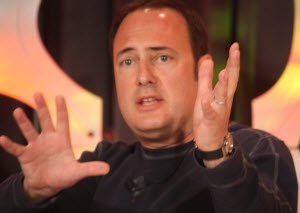 Steve Perlman (pictured at top and right), CEO of OnLive and a veteran of GamesBeat as a speaker, wowed the crowd in a few ways as he noted how game-streaming technology would impact mobile. He demoed OnLive working on an Apple iPad, showing a hardcore tennis game from the consoles working on the iPad. He also showed a fast browser that connects to servers as extremely fast speeds and then spits video back to the user, who can view the content in a split second.
Steve Perlman (pictured at top and right), CEO of OnLive and a veteran of GamesBeat as a speaker, wowed the crowd in a few ways as he noted how game-streaming technology would impact mobile. He demoed OnLive working on an Apple iPad, showing a hardcore tennis game from the consoles working on the iPad. He also showed a fast browser that connects to servers as extremely fast speeds and then spits video back to the user, who can view the content in a split second.
Perlman said that game publishers responded to streaming on mobile well because they’re so concerned about piracy of their games. Jailbroken phones are a big problem and in many territories such as China, publishers aren’t selling many games at all. Wibe Wagemans, the Hummingbird at Angry Birds maker Rovio, said his company’s brand is one of the three most-pirated brands in China. OnLive’s streaming technology can get around that. Rob Wyatt, chief scientist at game-streaming firm Otoy, said that streamed games aren’t nearly so easy to pirate, while downloadable games are always separated into files which can be intercepted and copies. Cheating in online games will also be a lot harder, Wyatt said.
Game-streaming could restore profitability for many games if mobile publishers adopt it, Perlman said. Some folks wonder if data caps enforced by broadband providers (as is the case with fellow, banned for a year for uploading too much) will stop game streaming in its tracks, as it requires a lot of data to be sent to users. Perlman said the data load isn’t that bad and that Netflix movie streaming is a much bigger data traffic problem.
But Perlman’s biggest “wow” moment came when he described Dido, a new wireless data transmission technology that his incubator, Rearden, has worked on fore a decade. The technology will let users log into wireless networks that have nearly unlimited bandwidth capacity, where the latency for users will be less than a millisecond. That means that this wireless technology will be faster than the fastest wired broadband networks and it will work well despite a crush of users flooding onto wireless networks. The combination of Dido and mobile OnLive could be pretty stunning.
The film resolution used in theaters is called 4k resolution — 4,096 pixels by around 2,000 pixels tall. Dido is designed to carry that kind of resolution at 240 frames per second at sub-millisecond latency, Perlman said. The technology is designed for OnLive, an online service that runs games on remote cloud servers and streams them over the Internet.
Game investor panel
 Sana Choudary, CEO of Yetizen, moderated our panel on investing in mobile and social games. On the panel were Tim Merel (pictured left), managing director of Digi-Capital; Tim Chang (pictured right), a partner at Norwest Venture Partners; and Suli Ali, CEO of TinyCo, which created a $5 million TinyFund to invest in small mobile game developers.
Sana Choudary, CEO of Yetizen, moderated our panel on investing in mobile and social games. On the panel were Tim Merel (pictured left), managing director of Digi-Capital; Tim Chang (pictured right), a partner at Norwest Venture Partners; and Suli Ali, CEO of TinyCo, which created a $5 million TinyFund to invest in small mobile game developers.
Merel said that the game markets are separating into two parts (he calls this the Big V), where one is focused on value and the other on volume. The value market includes the consoles and deep online games, while the volume includes social, mobile, and casual online games.
Ali said that the emergence of free-to-play business models is fundamentally changing Western game markets. He said there is a ton of money chasing good companies now, but the good thing is that the high valuations are going to companies with real revenues, lots of paying users, and profits. A lot of investors chase the best game development teams they can find.
Chang said that mobile gaming is a good place for developers to start, rather than social, since Zynga dominates Facebook. He said the market is both “frothy” and overvalued, and it is expanding and contracting at the same time. HTML5 and cloud-based gaming are also emerging to change the rules in the industry. PopCap Games’ acquisition will keep valuations frothy for a long time to come, he said.
The goal of getting real distribution remains a big one for most companies trying to carve out market share in mobile games. Chang said one successful strategy for game startups has been to be a fast copycat, as Zynga was described in its early days. Those companies can snare lots of users quickly and then become distribution powerhouses. Over time, they can improve their original games, but in the meantime they can wind the land rush.
Game companies raised $1.05 billion in 2010, up 58 percent from a year earlier. Only four of the top 20 companies on that list last year were mobile companies. This year, Zynga alone could raise more than $1 billion in one fell swoop with its expected initial public offering.
The momentum of this investment into mobile is clearly growing. TinyCo raised $18 million. Digital Chocolate raised $12 million. Pocket Gems raised $5 million. Rovio raised $42 million. The investors are also getting more interesting: Accel Partners, Kleiner Perkins, Sequoia Capital and Marc Andreessen are all moving into the market.
Merel said he expects acquisitions to continue, particularly as Chinese and other Asian companies acquire Western companies (going in the other direction often is harder because of tougher regulations on foreign ownership). But there’s a limit to how much expansion is possible, since many Chinese games just don’t sell that well in Western markets.
Chang said that power in the market either comes from owning great content or distribution. One company may start with one and then try to acquire the other. That drives the investment and acquisition machine.
Fireside chat with Wibe Wagemans
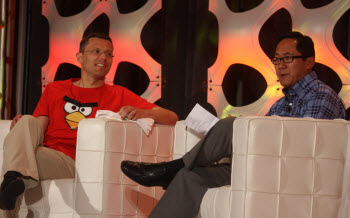 Wibe Wagemans, the Hummingbird (head of brand marketing, advertising and analytics) of Rovio, publisher of Angry Birds, threw his moderator, Rich Wong of Accel Partners, for a loop when he acknowledged that his company was considering raising a round of money, even after it raised $42 million from Accel and others in March.
Wibe Wagemans, the Hummingbird (head of brand marketing, advertising and analytics) of Rovio, publisher of Angry Birds, threw his moderator, Rich Wong of Accel Partners, for a loop when he acknowledged that his company was considering raising a round of money, even after it raised $42 million from Accel and others in March.
“I wasn’t aware of that myself,” joked Wong.
“We’re in fast growth mode, so we’re always on the lookout for good money,” Wagemans said. “We’re always interested.”
Wagemans talked about taking marketing opportunities at every step, like putting two Angry Birds aboard the last space shuttle mission, in order to build a brand that is as recognizable as Mickey Mouse. That’s crazy, but the Angry Birds game, which is easy to learn but hard to master, has been downloaded more than 200 million times.
Wagemans said that the company has succeeded with Angry Birds because of its relentless focus on its fans. It is aiming at getting 1 billion fans through basic brand management, where it understands fans and focuses on getting more and more users to keep paying the game through continuous updates. It is focused on broadening its distribution of a single game (and related games) across every possible game platform, including PCs, Android, iPhone and other platforms. The company is launching an Angry Birds book, it is working on a movie, and is opening stores in some regions. A new Facebook game will debut soon.
“It’s about how to get to as many fans as possible,” Wagemans said.
Wagemans said that Angry Birds is the third-most-copied brand in China, behind Disney and Hello Kitty. He joked his objective was to become the No. 1 most-copied brand in China. “We even found out we have two fans in North Korea,” he said.
Eric Goldberg (right), managing director of Crossover Technologies, ran a tight ship as he moderated our panel on game discovery on mobile. Mobile discovery is a critical issue still because there are hundreds of thousands of apps on the app stores and it’s hard to get noticed in that context. Even high-quality games can get lost.
The panel (pictured right to left) include Jussi Laakkonen, CEO of Applifier; Immad Akhund, co-founder of Heyzap; Dror Oren, executive director of ventures, licensing, and strategic programs at SRI International; and Colin Digiaro, chief operating officer of MindJolt.
Goldberg said his informal survey showed that the most popular way to get a game discovered is by having it featured by the platform owner, such as Apple. The second-biggest way was incentivized installs, which were banned as too manipulative by Apple. The third was word of mouth marketing, the fourth was free apps such as FreeAppADay.com; and the last was social networking.
Digiaro said that some lessons from Facebook discovery techniques can apply to mobile, such as an emphasis on sharing, badge rewards, and scores. Games that allow users to express themselves will also be shared more and spread in a more viral way. But Laakkonen said that mobile lacks the same communications channels that Facebook has. So mobile discovery is much harder and it has to be done with smaller screens and smaller numbers of words. The best way to spread a mobile game now is to take your phone and show a game to your friend — word of mouth.
“The question is how do I communicate to people that I care about this game,” Laakkonen said. “You need to be right there in the moment when someone is bored and you can show them something else.”
The good thing is mobile users try out a lot of games. The bad thing is attention spans are short. Akhund said that Heyzap’s game check-in app has driven 2 million installations of games at no cost to the game developers. The app works by letting users declare what game they’re playing to their mobile friends. Oren said that SRI is continuing to develop and spin off artificial intelligence and virtual assistant technologies that can help users discover apps that they want.
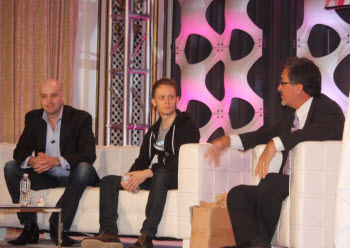 The shallow or the deep end of gaming
The shallow or the deep end of gaming
Lars Buttler (pictured left), the CEO of Trion Worlds, held a debate with Daniel Terry (pictured center), CEO of mobile game firm Pocket Gems about whether it was better to be in the deep end (hardcore) or shallow (casual) end of gaming. Trion Worlds has raised more than $100 million to build multiple massively multiplayer online games; it is focused on building games with huge average revenues per user and enormous lifetime value amounts (lifetime value is the amount of money expected to be generated by a user for the entire time the user plays the game), Buttler said. The percentage of users that are also monetized in these games is also very large and the barriers to entry are huge.
“Those are characteristics of the deep end,” he said. “We want to start where video games are today an top it.”
Trion’s first game, Rift, has more than a million users, and its goal is to give online gamers the same high quality experience as single-player games.
Terry said that his company is focused on making mobile games in the broad category of the game market. The goal is to get a larger number of users with a lower ARPU and lower lifetime value. The business model is free-to-play, monetized through the sale of virtual goods. Terry’s goal is to create a game that can hold the attention of a player from the very outset and keep the player’s attention from wandering to the many other mobile apps.
Michael Pachter (pictured above right), analyst at Wedbush Securities and moderator, said that Netflix has a value of about $600 per user (based on valuation divided by number of users); Zynga has a value of $40 per user ($10 billion value with 240 million monthly users). Facebook has a value of $70 per user (based on $49 billion and 700 million users). That shows you that Netflix is at the deep end, and that’s where Trion wants to be.
Fireside chat with Peter Relan
 So far, both the deep end and the shallow end of gaming are turning out to be very good businesses. Will that change one of these days?
So far, both the deep end and the shallow end of gaming are turning out to be very good businesses. Will that change one of these days?
Peter Relan, the CEO of social gaming firm CrowdStar and chairman of incubator YouWeb, spoke about his mobile strategy in a fireside chat. Going mobile was a big reason why CrowdStar recently raised $23 million from Intel Capital and Time Warner investments.
That funding will help CrowdStar expand into mobile and accelerate its global expansion. The company has ambitions to be big on Facebook, on mobile, and in Asia. Of those major markets, Facebook is likely to be the smallest business opportunity, Relan said. On Friday, Relan also announced that CrowdStar and YouWeb will launch a $10 million StarFund to invest in mobile game developers. The goal is to get a lot more games published under the CrowdStar label.
Overall, CrowdStar plans to focus on the female demographic on mobile devices. That demographic is huge but hasn’t been targeted with special games, Relan said.
Fireside chat with Neil Young
 Neil Young, the CEO of Ngmoco and an officer at DeNA, did a fireside chat with the Wall Street Journal’s Yukari Iwatani Kane. DeNA bought Ngmoco for up to $403 million last year as part of a global expansion from Japan to the West. Young is preparing to launch Mobage, DeNA’s mobile social network which is used by 28 million people in Japan, in the Western markets as well. In doing so, Ngmoco is using its ngcore technology to beef up Mobage for the smartphone market (it’s used for feature phones in Japan) so that it can be more appealing in Western markets.
Neil Young, the CEO of Ngmoco and an officer at DeNA, did a fireside chat with the Wall Street Journal’s Yukari Iwatani Kane. DeNA bought Ngmoco for up to $403 million last year as part of a global expansion from Japan to the West. Young is preparing to launch Mobage, DeNA’s mobile social network which is used by 28 million people in Japan, in the Western markets as well. In doing so, Ngmoco is using its ngcore technology to beef up Mobage for the smartphone market (it’s used for feature phones in Japan) so that it can be more appealing in Western markets.
Mobage is a very ambitious undertaking, sort of akin to creating something like Facebook on top of the Android market, and Young thinks it could be a billion-dollar opportunity, since the social network business of Mobage has already generated $1.3 billion in revenues for DeNA in Japan. DeNA makes money from sales of virtual goods in its first-party mobile games as we as from its 1,000 third-party mobile games in Japan. Now Mobage will replace Ngmoco’s Plus+ network in the U.S. The company is in a limited field trial for Mobage in Canada now and it will roll it out in the U.S. in the next few weeks.
Asked whether Ngmoco should rely on another network like Facebook, Young said, “I would think we would rather own an interest graph,” or the network that connects people via Over time, Ngmoco and DeNA want to have the global reach akin to that of a broadcast network and the monetization of a social gaming business. Ngmoco’s goal is to transition from an app developer with an affiliate network to a global platform company with world class first-party games and good third-party developer relations. It has to have great analytics, marketing programs and billing mechanisms.
“That’s a very big leap,” Young said.
Iwatani Kane said that Japan has been late to smartphones and wondered if what works over there will work in the U.S. Young said that the history of growth in Japan was fueled by underlying fundamentals such as flat pricing allowed Japan to move media service and frictionless mobile commerce. In the U.S., the path is very similar, given the fast growth of smartphone penetration, 3G services, and a huge app industry.
“The same behavior people laughed at about Japan — where everyone’s head is down looking at the phone — is taking hold in the U.S.,” Young said. “I’m not saying the U.S. is where Japan is today. The U.S. is five years behind and the opportunity ahead is incredible.”
“Who’s Got Game?” contest
 Our judges for our “Who’s Got Game?” best game startup contest included (from left to right) Terence Fung, head of corporate development at Zynga; Michael Chang, director of corporate development at Electronic Arts; Tim Chang, partner at Norwest Venture Partners; and moderator Sana Choudary, CEO of game startup accelerator YetiZen.
Our judges for our “Who’s Got Game?” best game startup contest included (from left to right) Terence Fung, head of corporate development at Zynga; Michael Chang, director of corporate development at Electronic Arts; Tim Chang, partner at Norwest Venture Partners; and moderator Sana Choudary, CEO of game startup accelerator YetiZen.
The judges screened 39 applications and whittled it down to eight finalists who appeared on stage. We had eight finalists were MetalCompass — a maker of social real-world games and peripherals for smartphones; Haptify — creator of games that make use of haptics, started by Immersion; Kaiju Empire – a developer that wants to bring back the Japanese classic monster characters; Zipline Games – maker of the Moai mobile game development platform; Protege Production — creator of DreamHome social network casual games Gbanga – developer of mixed-reality games; OneUp Games – a live sports game maker; and Guerillapps – maker of social games with green twist. I thought that all of the companies made great presentations.
The winner was Kaiju Empire, a social and mobile game maker that creates games based on Japanese-style Godzilla-like monsters. Kaiju had a cool monster creation and city-wrecking game that was the very beginning of a roadmap. Kaiju had a clear identity and lots of work already done. We expect great things from this startup, which won a spot in the next three-month class for YetiZen’s next set up startups.
Fireside chat with Keith Lee
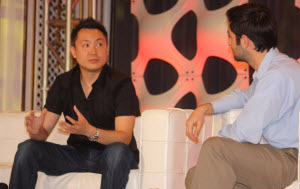 Keith Lee (pictured on the left in the photo at right), CEO of San Francisco-based mobile-location gaming firm Booyah, talked with Eric Eldon, editor of Inside Network and former senior editor at VentureBeat, about the company’s hit MyTown franchise, a location-oriented, mixed reality game where players could own real-world locations, Monopoly-style. MyTown was used by millions of users at its peak.
Keith Lee (pictured on the left in the photo at right), CEO of San Francisco-based mobile-location gaming firm Booyah, talked with Eric Eldon, editor of Inside Network and former senior editor at VentureBeat, about the company’s hit MyTown franchise, a location-oriented, mixed reality game where players could own real-world locations, Monopoly-style. MyTown was used by millions of users at its peak.
The company, which is backed by Kleiner Perkins, has decided to double down on mobile, shifting out of Facebook games and back into iPhone games such as its upcoming MyTown 2. That game is going to be launching soon and it will have new features like the ability to create your own buildings. Every building you create in MyTown 2 will be like a real building in real life. The real-life location element allows Booyah to work with brands and retailers to build promotions into the game itself.
Booyah prefers to use real-world locations because that makes its mobile games more social; you can connect to other people based on their interests in real-world locations. Lee said that MyTown had five or six times more engagement because it had a system where you could check in to a real-world location. That was an average of 55 minutes per session per day, much higher than the average. MyTown 2 will launch in a month or two.
“Today, people are excited about the idea of photo sharing and collective memory,” Lee said. “What I do see coming in the next 12 months is not just location but the integration of other technologies into the phone like near-field communications and point-of-sale connections. That will create a whole new set of experiences. You will be able to know someone is inside the Apple Store at a mall.”
Lee said his company was thinking about HTML5, but the challenge today is that location services need to rely navigation and accelerometer devices. That often requires native support, and so these features can’t be accessed at the moment by a browser app that is built in the HTML5 format.
Fireside chat with Andrej Nabergoj
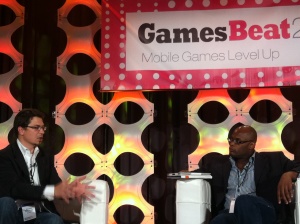 Andrej Nabergoj (pictured, on left) said in a fireside chat with Cliff Edwards of Bloomberg Businessweek that his goal is to take Talking Friends from its status as a hit mobile app to a full-fledged entertainment platform that lasts for decades. The CEO of Outfit7 in Palo Alto, Calif., said that Talking Friends has been downloaded more than 150 million times. But the company will partner with licensing firms to build its entertainment franchise, and it won’t raise money from investors.
Andrej Nabergoj (pictured, on left) said in a fireside chat with Cliff Edwards of Bloomberg Businessweek that his goal is to take Talking Friends from its status as a hit mobile app to a full-fledged entertainment platform that lasts for decades. The CEO of Outfit7 in Palo Alto, Calif., said that Talking Friends has been downloaded more than 150 million times. But the company will partner with licensing firms to build its entertainment franchise, and it won’t raise money from investors.
Outfit7 recently partnered with William Morris Entertainment’s Ari Emanuel, who inspired the HBO Entourage character Ari Gold, to expand their brand into traditional media. Also signed is licensing agency, Beanstalk. It may seem a bit aggressive, but Talking Friends has become a cultural phenomenon. A couple in Denmark was married by Talking Tom. The app helps a family understand their daughter who has cerebral palsy utilizing Tom’s high pitched and faster voice. Outift7 is even seeing half a million personal messages being sent using a Talking Friend video as the message content. Each new Talking Friends app hits a million users in a shorter amount of time; the most recent one got to 1 million units in a day. That means that Talking Friends has some serious distribution power.
“We raise money every month from our users,” Nabergoj joked. “We are profitable.”
Rise of tablet games
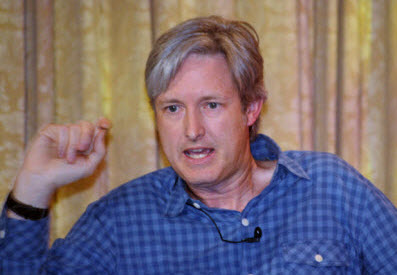 On the panel the Rise of Tablet games, Julian Farrior (pictured), CEO of Backflip Studios, could offer insight into the market because his company has sold more than 100 million mobile games. He said that current mobile games sell about 10 times more on the iPhone than they do on the iPad, but he is “extremely bullish” because the iPad has higher average revenue per user (ARPU), higher advertising revenue, and a longer duration of game play. Backflip’s Army of Darkness Defense tablet game has a 42 percent higher ARPU with iPad users than iPhone users.
On the panel the Rise of Tablet games, Julian Farrior (pictured), CEO of Backflip Studios, could offer insight into the market because his company has sold more than 100 million mobile games. He said that current mobile games sell about 10 times more on the iPhone than they do on the iPad, but he is “extremely bullish” because the iPad has higher average revenue per user (ARPU), higher advertising revenue, and a longer duration of game play. Backflip’s Army of Darkness Defense tablet game has a 42 percent higher ARPU with iPad users than iPhone users.
“I love where these trends are going,” he said. “The duration of play is 32 percent to 36 percent longer. If the trends continue, they could be as important as my iPhone game business.”
Rise of cross-platform games
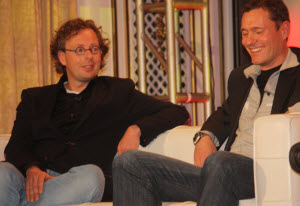 In our panel on the Rise of Cross-Platform Games, Kai Bolik, chief executive of Game Duell (pictured on right), and Peter Driessen (pictured left), CEO of Spil Games, discussed whether HTML5 was the solution for making games that can be created once and run on multiple platforms. Small developers are typically locked into one platform, such as the iOS. Games may cost as little as $80,000 to develop, but the costs add up if the games have to be reworked for each new platform.
In our panel on the Rise of Cross-Platform Games, Kai Bolik, chief executive of Game Duell (pictured on right), and Peter Driessen (pictured left), CEO of Spil Games, discussed whether HTML5 was the solution for making games that can be created once and run on multiple platforms. Small developers are typically locked into one platform, such as the iOS. Games may cost as little as $80,000 to develop, but the costs add up if the games have to be reworked for each new platform.
Native apps offer the advantage of speed and the ability to make use of specific features such as a camera or accelerometer. Some game developers are turning to hybrid platforms, such as the one from Sibblingz, which mix different development platforms together.
Fireside chat with Rob Wyatt
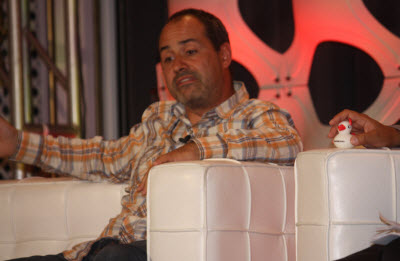 Rob Wyatt closed the conference with a proposal for “cloud consoles,” or game streaming technology that could liberate games from the platforms that Trip Hawkins complained about at the beginning. If game creators write their games to the cloud, which can use the huge computing power in data centers to execute game graphics, then the data center can dispatch video of the game over the internet to any game client. Cloud games could run on any platform, get rid of piracy, and prevent platform owners from extracting exhorbitant royalty fees.
Rob Wyatt closed the conference with a proposal for “cloud consoles,” or game streaming technology that could liberate games from the platforms that Trip Hawkins complained about at the beginning. If game creators write their games to the cloud, which can use the huge computing power in data centers to execute game graphics, then the data center can dispatch video of the game over the internet to any game client. Cloud games could run on any platform, get rid of piracy, and prevent platform owners from extracting exhorbitant royalty fees.
“You write games for this platform and play on any device, anywhere,” Wyatt said. “We can do Pixar-quality games in real time. We could play anything from Tetris to Uncharted. As long as it can decode a stream, we can play it on that device.”
Wyatt said the technology has been in the works for a dozen years. But where Onlive has hundreds of employees, Otoy only has 20. If their technology works, then the game consoles may never see another generation, Wyatt said. You could buy a smart, connected TV with a game controller and use that to play streamed games on the TV, without a console. Console makers can adapt to the cloud or become obsolete.
The question about data caps came up again, but Wyatt, a 26-year veteran of games and a co-creator of the original Xbox and the PlayStation 3, said the amount of data associated with games won’t be overwhelming. The wired and Wi-Fi networks of today are more than capable of supporting cloud gaming, but wireless mobile networks aren’t yet capable, Wyatt said.
In any case, Wyatt’s talk was a fitting close to the conference since Otoy’s technology is an answer to Hawkins’ complaint at the beginning that game developers have always been at the mercy of the feudal lords.
“We will license our technology,” he said. “We don’t want to host the platform. We don’t want to be the gatekeepers of the platform. We won’t say what you can and can’t do on the platform. We will provide the technology.”
VentureBeat's mission is to be a digital town square for technical decision-makers to gain knowledge about transformative enterprise technology and transact. Learn More
